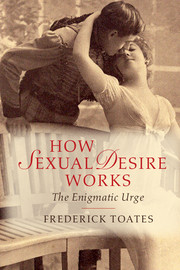Book contents
- Frontmatter
- Dedication
- Contents
- List of figures
- Preface
- One What is enigmatic about sexual desire?
- Two Explaining desire: multiple perspectives
- Three Sexual desire in a broad context
- Four An incentive-based model
- Five Sex and levels of organization
- Six Sexual attraction
- Seven Shades of desire from simple to complex
- Eight Details of the brain and desire
- Nine Arousal
- Ten The consequences of sexual behaviour and associated expectations
- Eleven Sexual familiarity and novelty
- Twelve Inhibition, conflict and temptation
- Thirteen How did sexual desire get here?
- Fourteen Setting the trajectory: link to adult sexuality
- Fifteen Sexual desire in interaction
- Sixteen Representations of sex
- Seventeen Sexual addiction
- Eighteen Variations in desire: general principles
- Nineteen Some forms of desire at the fringes
- Twenty The toxic fusion: violence and sexual desire
- Twenty one Sexually associated (serial) murder
- Twenty two Concluding remarks
- Notes
- References
- Index
Seven - Shades of desire from simple to complex
Published online by Cambridge University Press: 05 October 2014
- Frontmatter
- Dedication
- Contents
- List of figures
- Preface
- One What is enigmatic about sexual desire?
- Two Explaining desire: multiple perspectives
- Three Sexual desire in a broad context
- Four An incentive-based model
- Five Sex and levels of organization
- Six Sexual attraction
- Seven Shades of desire from simple to complex
- Eight Details of the brain and desire
- Nine Arousal
- Ten The consequences of sexual behaviour and associated expectations
- Eleven Sexual familiarity and novelty
- Twelve Inhibition, conflict and temptation
- Thirteen How did sexual desire get here?
- Fourteen Setting the trajectory: link to adult sexuality
- Fifteen Sexual desire in interaction
- Sixteen Representations of sex
- Seventeen Sexual addiction
- Eighteen Variations in desire: general principles
- Nineteen Some forms of desire at the fringes
- Twenty The toxic fusion: violence and sexual desire
- Twenty one Sexually associated (serial) murder
- Twenty two Concluding remarks
- Notes
- References
- Index
Summary
The world is an inherently complex place which to a large extent is too complex to be grasped and comprehended by the human intellect. Faced with this complexity we do the best we can – we formulate models which represent our limited grasp of reality.
(Bancroft, 2000, p. 204)This chapter looks in more detail at both universal and idiosyncratic features of desire. The contribution of arousal is considered mainly in Chapter 9.
Two principal and closely related themes run through this account of desire:
Different levels of control underlie desire.
Some aspects of desire can be understood through the subjective insight of the person having the desire. Other aspects are beyond such insight and can only be studied with the tools of objective science.
So, what exactly triggers sexual desire?
The diversity and richness of sexual desire
At the basic level
Imagine aman walking near a red-light district and suddenly being propositioned. His thoughts and intentions might have been far from the erotic but sexual desire and arousal were instantly created by the invitation. The woman’s physical properties dominate the ‘stimulus-driven’ control of the client’s behaviour. Just one goal, immediate unconditional pleasure, dominates, with little or no emotional empathy, concern for the pleasure of the woman or thought of the future.
- Type
- Chapter
- Information
- How Sexual Desire WorksThe Enigmatic Urge, pp. 134 - 144Publisher: Cambridge University PressPrint publication year: 2014

